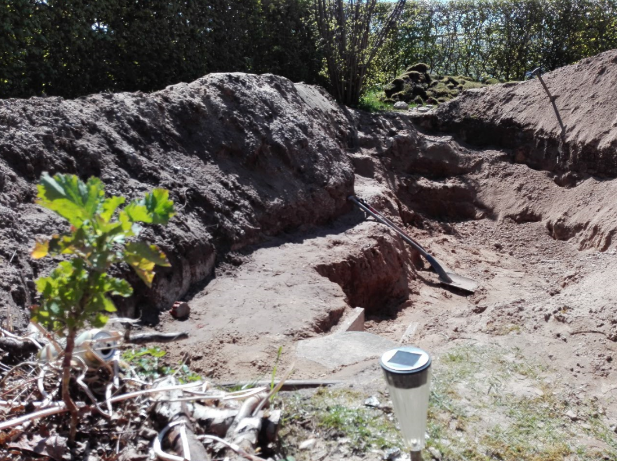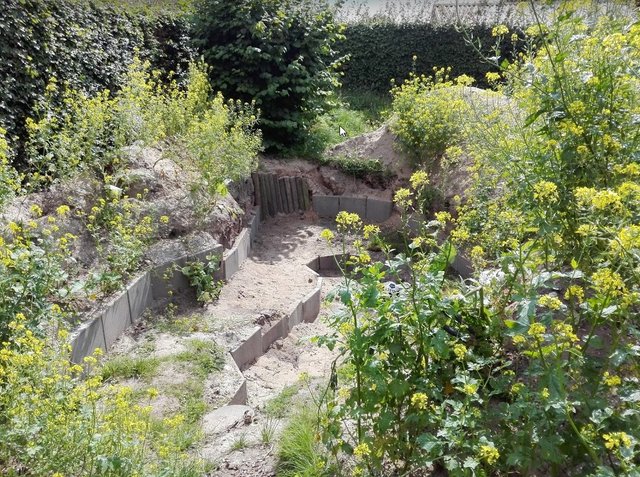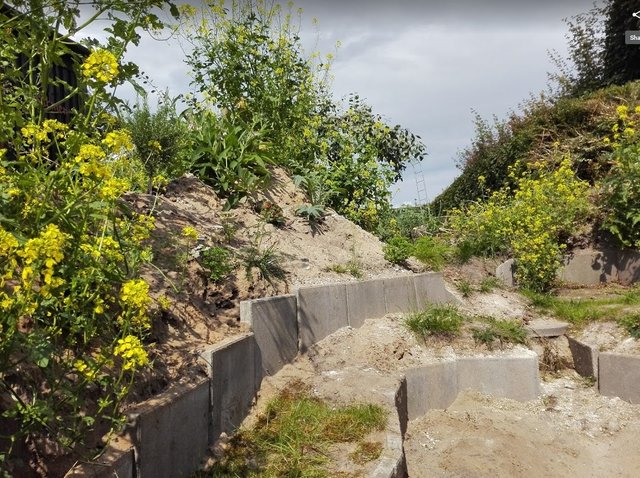An introduction to a forest garden project!
Greetings Steemit!
I’ve decided to share my work with you, and hopefully I’ll be able to provide an introductory perspective of what has been a more than three year long process of attaining some idea of what exactly I’m doing. With such a vague intro, allow me to focus the lens with this; I’ve fallen in love with plants, and as such I’m currently living in an approximately 16 sq mt house in Denmark, surrounded by a 320 sq mt garden, which I’ve turned from a barren field of grass dotted with a plum tree, hazels, and a staggering four apple trees(all late-ripening varieties), into the very onset of a lush forest garden. As I sit and think about the number of plants I’ve introduced after my one-year mark of ownership(although I didn’t spend the winter here), I seem be at a loss. I would however assume, that the number of species I’ve planted within the garden would be well above 40.
One example would be the low ground-cover species Nepalese raspberry(rubus nepalensis), which in my experience hasn’t ventured higher above ground than 20 centimeters. This particular plant spreads along the soil, covering it in a dense dark-green vegetation, and the beauty of it all is the fruits! It blooms white flowers in the mid-summer, leaving you with marvelous raspberries the following month. While covering the soil, thereby protecting the topsoil from beating rain or scorching sunlight, microbial life begins to flourish, working their metabolisms towards making the greatest conditions for life, by dismantling dead organic matter into simpler compounds and thereby redistributing nutrients which allows the lovely Nepalese raspberry and its companions to flourish!
The picture below is from earlier this year, when some friends and I began some land-chiropractics in order to create warm micro-climates, increase the surface area of the garden, and make a lovely place to hang out!

As I’m working with a forest garden design, meaning trying to mimic the forest while accommodating the people living within it, I’m working in layers throughout the garden while carefully making sure that the amount of sunlight available now can accommodate the species I plant there, and if possible, sufficiently even in 5 years when the density of the forest garden has increased significantly. Another key thing is how the plants interact with each other, or what kind of key-roles they naturally posses.
A practical example of how this works is the area around my plum tree. Around my plum tree I’ve planted comfrey(symthytum officinale, bocking 14 variety), a brilliant mineral accumulator with deep taproots, the deepest I’ve heard about being 8 meters, and bringing up minerals from the subsoil to the surface in the form of leaves, beautiful flowers and an abundance of growth. This growth can be used to fertilize the topsoil by simply chopping the plant and laying it in situ, or you can do more labor-intensive methods such as fermenting your own liquid fertilizer. Many reasons as to why this plant ended up next to the plum tree can be listed, but the main goals for the decision when taking into account the whole of the garden, would be to increase annual biomass production, further increase diversity, more full-season flowers for pollinators and medicine. And of course, the very obvious reason is to feed my plum tree.
Under the canopy of the plum a salad burnet(sanguisorba minor) is also to be found. This lovely perennial shoots out cucumber-tasting leaves like there’s no tomorrow, a true delight when added to dishes, or raw even. This plant main focus is not the feeding of the tree, but rather a food crop. About 95% of the plants I’ve introduced are edible in one way or the the other, ranging from tender leaves to tasty aromatic flowers, or starchy roots.
I started getting an interest in plants and their interaction with each other a bit more or less than three years ago, around the time when I moved to an apartment devoid of anything resembling a garden. Through my time there I started planting a few spices from seed and putting them in a sunny spot, and from there I went out at got myself two 300w LED's and installed them on a shelf, where strawberries, seed-stared avocado and others where flourishing underneath. But something felt awful about growing plants in such an isolated environment, where even the soil is sterile. As I found my way to permaculture and from there, forest gardening, I at one point gained a clear knowledge of what I had to do. As such I purchased a small house with the previously mentioned 320 sq mt garden.
Some friends of mine have requested I produce a bit of material on what I’m actually doing out here, and as such I figured I might as well start!
Feel free to ask questions, or join in with ideas as we go along, I’d love to gain new insights.
Therefore let this be the opening post to the story of this little piece of land, and how I interact with it, striving to work with it, and not against it.
I look forward to hearing from you,
Kasper.
P.S. I will update with new photos tomorrow when I wake up, in order to grant you an idea of how the forest garden looks this early in development.
EDIT 1:
Here's an up-to-date photo of the same spot as the previous photo.
Underneath is yet another photo of the same location, but taken from within the hole.

One of the main issues with this project is erosion. Therefore tap-rooted plants such as the previously mentioned Comfrey, and Cardoon(Cynara cardunculus) has been carefully placed in order to create living beams of integrity. Both plants are excellent at gathering nutrients from the subsoil and producing an abundance of biomass, perfect for restoring the disturbed soil. On the very top of the 'hill' in the above photo rests a Sea Buckhorn(Hippophae rhamnoides), a potentially big shrubby tree, growing to 6 x 2,5 meters at best, and producing incredibly nutritious orange fruits. However, as it is single-sexed, it requires both a male and female plant for pollination, therefore three are planted within the garden, as sex is undetermined.
The yellow flowering plants(White Mustard, Sinapis alba) that occupy a great many places, are planted not as a food crop, but rather a temporary layer for biomass and pollination. It's a self-seeding annual, meaning it will be out-competed throughout the years as the perennial forest garden takes hold.
Returning to the problem of erosion and therefore a decrease in soil fertility, another method I might end up employing would be, a barrier of bamboo to hold back dead organic matter, and therefore build the soil top-down.
Any other ideas to fix the problem of erosion will be appreciated.
I'll update with more photos later on, with an introductory description of a different part of the forest garden, where introduced edible fungi has already fruited!

I'll be interested in following your project! I'm planning a permaculture food forest myself, in a meadow with a plum, some hawthornes and wild apples... sound familiar? I'll be curious to hear how you like Seabuckthorn berries, as I've yet to taste them myself. I wish I had some advice for you, but I can say that your photos and everything you've said indicate a great start. If you're looking for some good reading, I've been really enjoying Michael Roads and his conversations with Nature. Good weather to ya!
Hi there!
Great to hear you're steering in on a similar path, the very process of building, designing and scavenging if needed for the food forest has in my case been incredibly rewarding. I feel more at home by the day!
I'm curious about how tasty they are as well, I've only had marmalade and gel with seaberries, both of which I loved due to the natural sourness of it. Maybe it's foraging time!
But thank you for the pad on the back, and you've just peaked my interest with Michael Roads, I'll be sure to check him out.
Best of luck to you!
Really nice project! More pictures!
I'll snap a few within the next hour or so.
Stay tuned!
Looking forward!
Nice friends!
Definitely!
We talked about it recently, and got to the conclusion that we've actually dug up a few tonnes of earth, clay, chalk and sand.
In the photo attached to the post, you can see the grip of a shovel sticking out of the earth - it actually broke during the excavation!
Hi curiosity!
I read your work. Sorry to tell you nothing. I'm not good at problems of soil erosion.
I'm sure you'll be fine. You can do it.
You came here looking for a solution to the problem and you'll find him!
Good luck!
Thank you man, I'm sure I'll find plenty of good ideas here as time passes. :-)